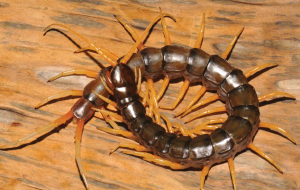Just three months after a “walking” fish was discovered, another group of scientists has unearthed the a species of amphibious centipede.
National Geographic reports that the amphibious centipede is a family member of the Scolopendra and grows up to 20 centimeters (7.9 inches) long. The “swimming” centipede can be found prowling in streams located in mainland Southeast Asia.
The discovery began in 2001 when George Beccaloni, an entomologist (one who studies insects) from the Natural History Museum in London, was on his honeymoon in Thailand.
“Wherever I go in the world, I always turn over rocks beside streams, and that’s where I found this centipede, which was quite a surprise,” Beccaloni told National Geographic.
“It was pretty horrific-looking: very big with long legs and a horribly dark, greenish-black color,” he said. He then incarcerated the centipede in a container filled with water and brought the species to the museum.
Years passed and Beccaloni, together with his colleague Gregory Edgecombe and his Thai student Warut Siriwut, ventured on a wild expedition to hunt for new species of centipede. The trio acquired two centipedes near a waterfall in Laos and they were named Scolopendra cataracta, derived from the Latin term for “waterfall.” The centipede’s venom is not deadly, but it can penetrate the human skin and smolder a lengthy portion of it for days. Currently, there are four species of the centipede displayed at the museum, with the first one discovered in Vietnam in 1928.
Beccaloni theorized that there’s a “whole other range of interesting amphibious things that come out at night,” and Mother Nature has a lot of wonders waiting to be discovered by scientists.
In March, another group of scientists discovered Cryptotora thamicola, a type of waterfall cavefish, in Thailand. Gianna Francesca Catolico
RELATED STORY:
MOST READ
LATEST STORIES
